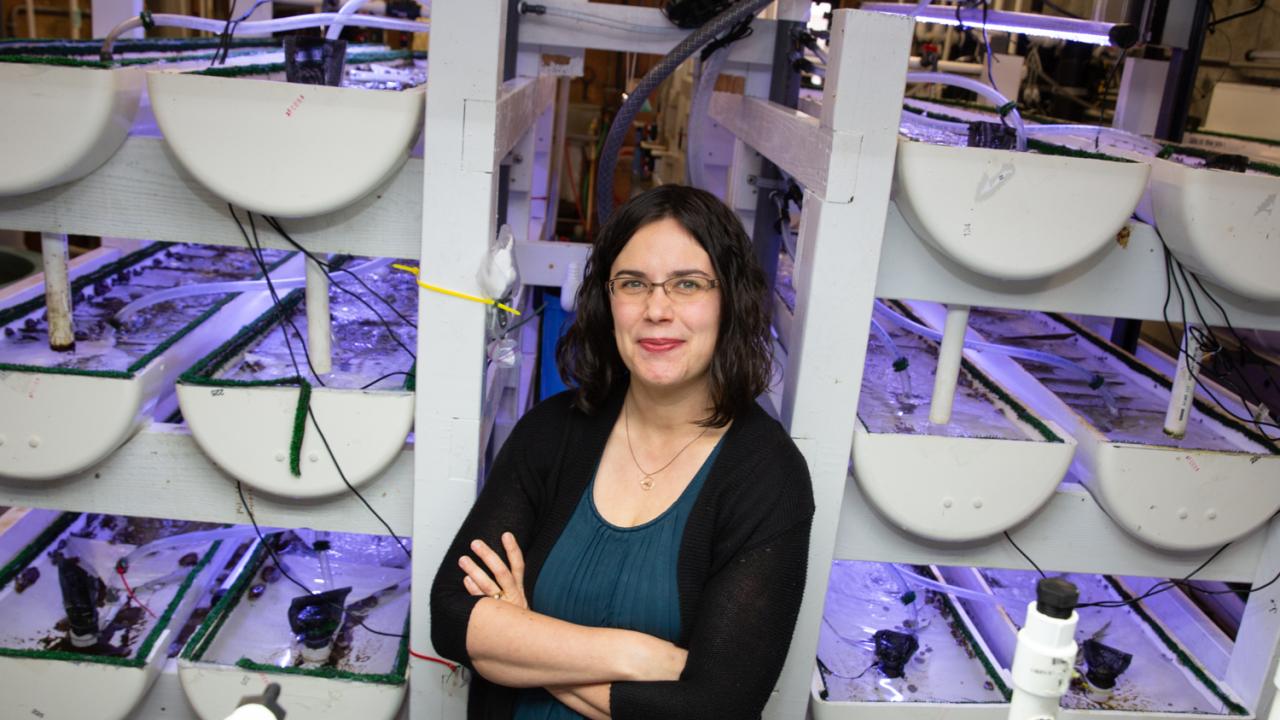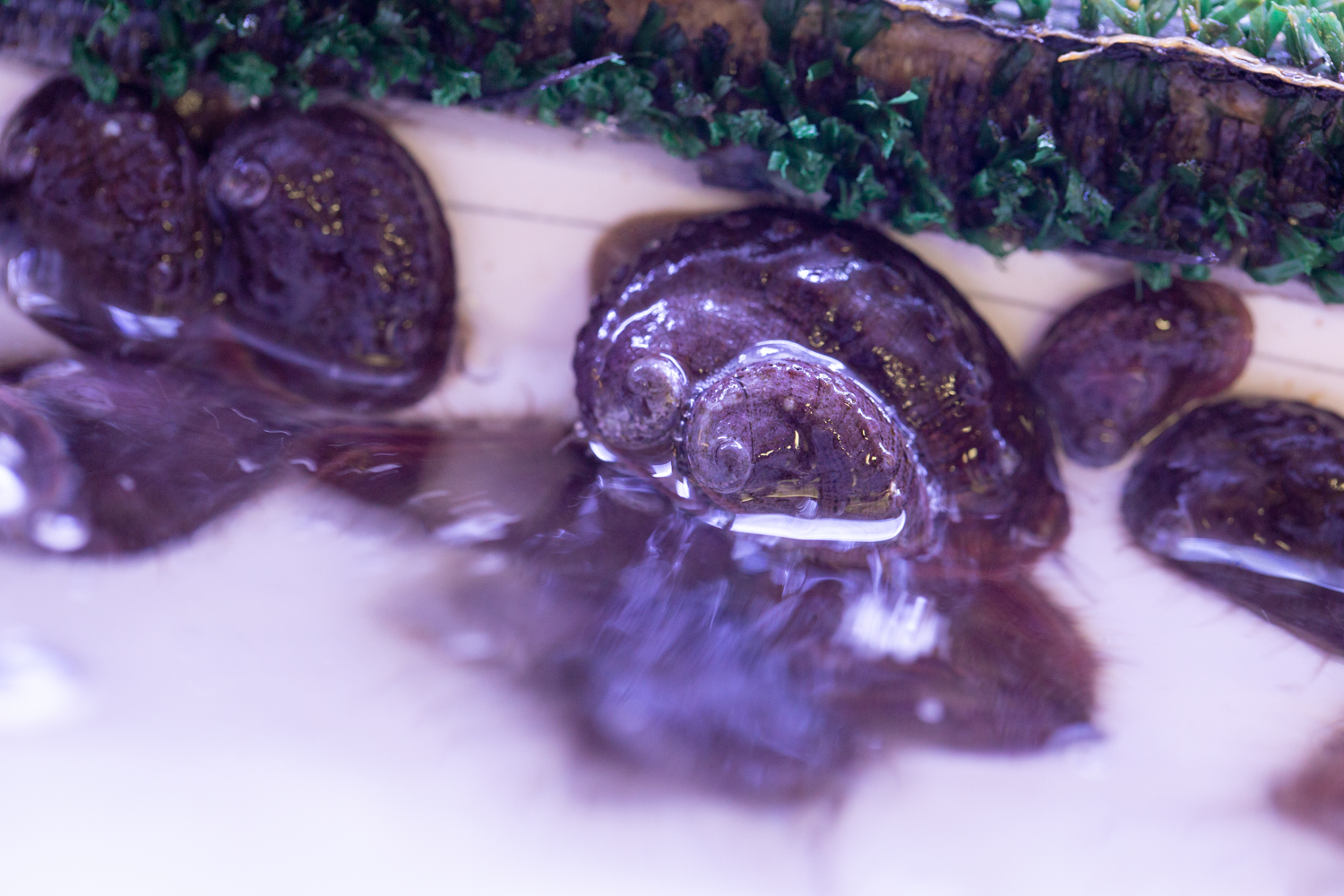
Discovering Curiosity: Saving the White Abalone with Kristin Aquilino
Quick Summary
- A UC Davis alumna, Kristin Aquilino directs the Bodega Marine Laboratory's white abalone captive breeding program
- In 2001, the marine snail was officially listed as endangered
- Using captive breeding, Aquilino and colleagues hope to bring the species back from the brink of extinction
About 375 million years ago, the state of Iowa lay submerged beneath an ocean. Marine creatures—like giant sea scorpions, snails and primitive fish—skittered, crawled and swam through these waters. Today, scientists and researchers have a close-up view of these prehistoric animals thanks to sites like the Devonian Fossil Gorge, which is located in Iowa City and was unveiled by a flood in 1993.
Kristin Aquilino, an assistant project scientist at the UC Davis Bodega Marine Laboratory, remembers that flood. She was a child when it occurred, and her father took her to a nearby spillway to watch hurtling waters cascade into the earth.
Though today Iowa is thousands of miles from both the Pacific and Atlantic oceans, the fossilized seafloor is a reminder of our constantly shifting Earth. And in a way, it was a sign of Aquilino’s future career as an ocean scientist.

From alfalfa fields to the ocean
Aquilino spent her upbringing in Iowa City exploring the woods that surrounded her home. She built paths, hunted for morel mushrooms and caught tadpoles in a nearby pond. The surroundings fed her interest in biodiversity, a subject area she later studied in more detail as an undergraduate at the University of Wisconsin-Madison.
“I was really interested in what happens when you add species to a system, like an invasion; or you subtract species from a system, like an extinction,” said Aquilino. “I was asking these really cool questions about that in agroecosystems, like in alfalfa fields, and I loved the questions I was asking.”
“I did not love the environment,” she added.
Following graduation, Aquilino decided a change of scenery was necessary. She heard about the work of UC Davis Professor Jay Stachowicz, Department of Evolution and Ecology. Stachowicz, it turned out, asked similar questions as Aquilino but investigated them using a different ecosystem, the ocean’s intertidal zones.
“They brought me out here, and I was like, ‘How could I not come to this place?’” recalled Aquilino, who graduated from UC Davis with a Ph.D. in Population Biology in 2011. “The Bodega Marine Lab and Reserve are so magical.”
Today, Aquilino is the director of the Bodega Marine Laboratory’s white abalone captive breeding program. She’s spent years investigating ways to help bring this species back from the brink of extinction. Last year, the National Oceanic and Atmospheric Administration honored Aquilino for her work with the Species in the Spotlight Recovery Hero Award.
“As a kid in Iowa, this was not something that I had in my purview at all,” said Aquilino. “Saving an endangered sea snail was just not there.”

A species in need of saving
Inside the White Abalone Culture Facility on the Bodega Marine Laboratory’s grounds, machines hum and water burbles. The facility’s full-spectrum lights are synced to astronomical clocks, following sunrise and sunset in Santa Barbara, near the center of white abalone’s range. As much as 86,000 gallons of water from Horseshoe Cove pumps daily through the facility, where it’s treated by ultraviolet lights to eliminate harmful bacteria and then pumped to “baby abalone cradles,” as Aquilino calls them. Arranged in shelves, this nursery of 16,000 juvenile abalone represents the future of the species.
White abalone are one of seven abalone species in California. Once prominent, these marine snail species hold great cultural significance. Their shells were traded as far back as 5,000 years ago, and were used as tools, ornaments and jewelry, according to NOAA.
“Native people of this area have been harvesting abalone for thousands and thousands of years and have a very strong connection to them still,” said Aquilino. “Their shells were used as currency.”
White abalone were perilously overfished throughout the 20th century, resulting in a 99 percent population decrease by the end of the 1970s. Once numbering in the millions, NOAA estimates today’s wild populations are around 1,600 to 2,500. In 2001, the species was officially listed as endangered.
Even before formally studying abalone, Aquilino formed a personal connection with the animal. In 2006, she began scuba diving and started helping the California Department of Fish and Wildlife with red abalone surveys. On a California Department of Fish and Wildlife research cruise, she met the man who would later become her husband, a fellow abalone diver. The gem of Aquilino’s engagement ring is an abalone pearl. Her husband found it while diving.

White abalone breeding 101
Part of the problem of revitalizing white abalone is due to their unique reproductive process.
“White abalone are broadcast spawners,” said Aquilino. “They send their eggs and sperm into the water column. These combine to form an embryo, which sinks to the seafloor and after about 24 hours, a swimming larva hatches out.”
After about a week, the larvae—which feed on yolk—go through an energetically costly metamorphosis, transforming into crawling snails.
Successful reproduction requires adult males and females to be located within a few meters of one another. If positioned farther, their gametes can’t fertilize. With such small numbers, wild breeding populations have become a rare occurrence.
With captive breeding, researchers have had greater breeding success. Using a hydrogen peroxide solution, they can create artificial cues that trigger abalone to spawn.
“We know how to make a lot of abalone on land,” said Aquilino. “So if we just take their gametes, get them close together in the lab, rear up the babies and put them back out in the wild, we should be able to save them.”

Overcoming hurdles to conservation
Despite the success, there’s still much researchers have to contend with on the path to species recovery. In one of the first white abalone spawning attempts, researchers collected 20 white abalone from the wild and spawned them to create 100,000 juveniles at a research facility in Southern California. According to Aquilino, when those animals were about one year old, around 95 percent died. The culprit, a disease known as withering syndrome.
“It’s caused by a bacterium that affects the esophagus of the abalone, and it’s interesting because it’s temperature dependent,” said Aquilino. “So in cold water, the animals can have the bacteria and they seem totally fine. When the water gets warm, the bacteria proliferate.”
According to Aquilino, the disease manifests within abalone when temperatures reach roughly 64 degrees Fahrenheit. When the bacteria infection spreads, the animal stops eating and digests its foot muscle. The abalone then falls off its substrate and dies.

UC Davis researchers have developed an antibiotic bath treatment to rid their abalone of the bacterium that causes withering syndrome. But the species still faces an upward battle.
Since the 1990s, according to Aquilino, the white abalone population has declined at a rate of 12 to 14 percent each year. To reverse this trend, she and her colleagues are preparing to outplant adult white abalone in select locations off the coast of Southern California.
“We’re still not at that 100,000 animals a year level that they had the first time and we probably need to be there in order to save the species,” said Aquilino. “We probably need to be outplanting, or stocking, tens of thousands to 100,000 white abalone every year.”
According to Aquilino, there’s something the lab hasn’t yet discovered when it comes to abalone captive reproduction. She suspects captive abalone might be missing some natural cue wild abalone receive in the month or two before spawning that signals for them to direct energy towards gonad development.
“That’s some of our research as well,” she said. “What is the recipe that gets them to produce more gametes to begin with so then they have something to spawn?”
Aquilino said that she hopes to have outplanting permits ready in the next year.
“I can’t wait to dive down and put them out there for the first time,” she said. “It’s like sending your kids to college.”
